Numerical Study on the Effect of Z-Warps on the Ballistic Responses of Para-Aramid 3D Angle-Interlock Fabrics
Abstract
:1. Introduction
2. Finite Element Models for Fabrics under Ballistic Impact
3. Results and Discussion
3.1. Time History of the Projectile
3.2. Energy Absorption
3.3. Fabric Deformation
3.4. Deformation of Fabric Panels
3.5. Stress Distribution
3.5.1. In-Plane Stress Propagation
3.5.2. Stress Propagation through the Panel Thickness
4. Conclusions
- The overall ballistic protection performance of 3D AI fabric is better than that of laminated 2D plain fabrics by exhibiting an up to 88.1% higher SEA and a 7.7% smaller indentation.
- When impacted by a projectile, the 3D fabric is more inclined to convert the impact kinetic energy of the projectile into elastic strain energy, indicating more secondary yarns involvement in energy absorption of the 3D fabrics.
- While the 2D fabrics present earlier failure layer by layer, the 3D AI fabric has a smaller indentation and 8.4 μs longer resistance time than 5-plain, due to the cohesion of the Z-warp yarns. Therefore, the structure of 3D fabric can more effectively suppress the back-face deformation and possess better penetration resistance.
- 3D AI fabric has a wider range of in-plane stress propagation in the panel back-face, while the laminated 2D fabrics experiences a stress concentration on the impact surface. It indicates that the 3D fabric has a better capacity of in-plane stress propagation when compared with 2D fabrics.
- Compared with the 2D fabric, the responding time of the back-face node in 5-AI is about 1 µs later due to the higher level of Z-warps crimp and the less interlacements between the weft layers in the 3D fabric.
Author Contributions
Funding
Data Availability Statement
Conflicts of Interest
References
- Laible, R.C. Ballistic Materials and Penetration Mechanics, 5th ed.; Elsevier Science Publishers: Amsterdam, The Netherlands, 2012. [Google Scholar]
- Abtew, M.A.; Boussu, F.; Bruniaux, P.; Loghin, C.; Cristian, I. Ballistic impact mechanisms—A review on textiles and fbre-reinforced composites impact responses. Compos. Struct. 2019, 223, 110966. [Google Scholar] [CrossRef]
- Yang, C.C.; Ngo, T.; Tran, P. Influences of weaving architectures on the impact resistance of multi-layer fabrics. Mater. Des. 2015, 85, 282–295. [Google Scholar] [CrossRef]
- Shimek, M.E.; Fahrenthold, E.P. Effects of weave type on ballistic performance of fabrics. AIAA J. 2012, 50, 2558–2565. [Google Scholar] [CrossRef]
- Zhou, Y.; Chen, X. A numerical investigation into the influence of fabric construction on ballistic performance. Compos. B. Eng. 2015, 76, 209–217. [Google Scholar] [CrossRef]
- Yang, Y.; Zhang, X.; Yang, D.; Min, S. Review on the development of fiber reinforced composites for military helmet shells. J. Beijing Inst. Fashion Technol. 2019, 39, 93–100. [Google Scholar]
- Yang, Y.; Chen, X. Study of energy absorption and failure modes of constituent layers in body armour panels. Compos. B. Eng. 2016, 98, 250–259. [Google Scholar] [CrossRef]
- Ghosh, R.; De, S. Z-fiber influence on high speed penetration of 3D orthogonal woven fiber composites. Mech. Mater. 2014, 68, 147–163. [Google Scholar] [CrossRef]
- Chen, X.; Yang, D. Use of 3D angle-interlock woven fabric for seamless female body armor: Part 1: Ballistic evaluation. Text. Res. J. 2010, 80, 1581–1588. [Google Scholar] [CrossRef]
- Min, S.; Chai, Y.; Chen, X.; Leonard, F. Engineering of military helmet shells with continuous textile reinforcement. In Proceedings of the 89th Textile Institute World Conference, Wuhan, China, 2–6 November 2014. [Google Scholar]
- Min, S.; Chai, Y.; Chu, Y.; Chen, X. Effect of panel construction on the ballistic performance of multiply 3D through-the-thickness angle-interlock fabric reinforced composites. Polymers 2019, 11, 198. [Google Scholar] [CrossRef] [Green Version]
- Chocron, S.; Figueroa, E.; King, N.; Kirchdoerfer, T.; Nicholls, A.E.; Sagebiel, E.; Weiss, C.; Freitas, C.J. Modeling and validation of full fabric targets under ballistic impact. Compos. Sci. Technol. 2010, 70, 2012–2022. [Google Scholar] [CrossRef]
- Chen, X.; Zhu, F.; Wells, G. An analytical model for ballistic impact on textile based body armour. Compos. B. Eng. 2013, 45, 1508–1514. [Google Scholar] [CrossRef]
- Chu, Y.; Rahman, M.R.; Min, S.; Chen, X. Experimental and numerical study of inter-yarn friction affecting mechanism on ballistic performance of Twaron® fabric. Mech. Mater. 2020, 148, 103421. [Google Scholar] [CrossRef]
- Zhou, Y.; Chen, X.; Wells, G. Influence of yarn gripping on the ballistic performance of woven fabrics from ultra-high molecular weight polyethylene fibre. Compos. B. Eng. 2014, 62, 198–204. [Google Scholar] [CrossRef]
- Wang, Y.; Chen, X.; Young, R.; Kinloch, I. A numerical and experimental analysis of the influence of crimp on ballistic impact response of woven fabrics. Compos. Struct. 2016, 140, 44–52. [Google Scholar] [CrossRef]
- Hou, Y.; Sun, B.; Gu, B. An analytical model for the ballistic impact of three dimensional angle-interlock woven fabric penetrated by a rigid cylindro-spherical projectile. Text. Res. J. 2011, 81, 1287–1303. [Google Scholar]
- Jia, X.; Sun, B.; Gu, B. A numerical simulation on ballistic penetration damage of 3D orthogonal woven fabric at microstructure level. Int. J. Damage Mech. 2012, 21, 237–266. [Google Scholar] [CrossRef]
- Kędzierski, P.; Popławski, A.; Gieleta, R.; Morka, A.; Sławiński, G. Experimental and numerical investigation of fabric impact behavior. Compos. B. Eng. 2015, 69, 452–459. [Google Scholar] [CrossRef]
- Nilakantan, G.; Merrill, R.L.; Keefe, M.; Gillespie, J.W.; Wetzel, E.D. Experimental investigation of the role of frictional yarn pull-out and windowing on the probabilistic impact response of kevlar fabrics. Compos. B. Eng. 2015, 68, 215–229. [Google Scholar] [CrossRef]
- Shanahan, W.J.; Hearle, J.W.S. 12-An energy method for calculations in fabric mechanics Part II: Examples of application of the method to woven fabrics. J. Text. Inst. 1978, 69, 92–100. [Google Scholar] [CrossRef]
- Chu, Y.; Min, S.; Chen, X. Numerical study of inter-yarn friction on the failure of fabrics upon ballistic impacts. Mater. Des. 2017, 115, 299–316. [Google Scholar] [CrossRef]
- Tran, P.; Ngo, T.; Yang, E.C.; Mendis, P.; Humphries, W. Effects of architecture on ballistic resistance of textile fabrics: Numerical study. Int. J. Damage Mech. 2014, 23, 359–376. [Google Scholar] [CrossRef]
- Lim, C.T.; Shim, V.P.W.; Ng, Y.H. Finite-element modeling of the ballistic impact of fabric armor. Int. J. Impact Eng. 2003, 28, 13–31. [Google Scholar] [CrossRef]
- Wang, Y.; Chen, X.; Young, R.; Kinloch, I.; Wells, G. A numerical study of ply orientation on ballistic impact resistance of multi-ply fabric panel. Compos. B. Eng. 2015, 68, 259–265. [Google Scholar] [CrossRef]
- Min, S.; Chu, Y.; Chen, X. Numerical study on mechanisms of angle-plied panels for ballistic protection. Mater. Des. 2016, 90, 896–905. [Google Scholar] [CrossRef]
- Yang, D.; Chen, X.; Sun, D.; Zhang, S.; Yi, C.; Gong, X.; Zhou, Y.; Chen, Y. Ballistic performance of angle-interlock woven fabrics. J. Text. Inst. 2017, 108, 586–596. [Google Scholar] [CrossRef]
- Chu, Y.; Chen, X. Finite element modeling effects of inter-yarn friction on the single-layer high-performance fabrics subject to ballistic impact. Mech. Mater. 2018, 126, 99–110. [Google Scholar] [CrossRef] [Green Version]
- Smith, J.C.; McCrackin, F.L.; Schiefer, H.F. Stress-strain relationships in yarns subjected to rapid impact loading: Part V: Wave propagation in long textile yarns impacted transversely. Text. Res. J. 1958, 28, 288–302. [Google Scholar] [CrossRef]

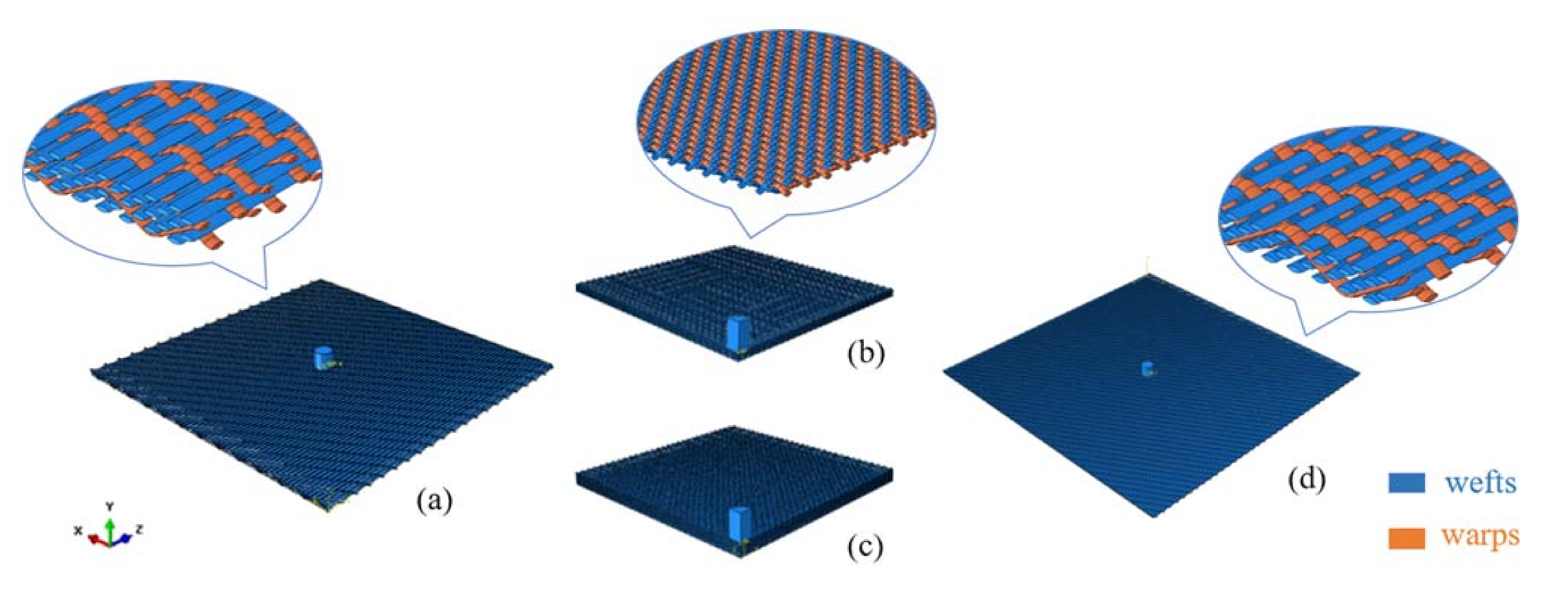


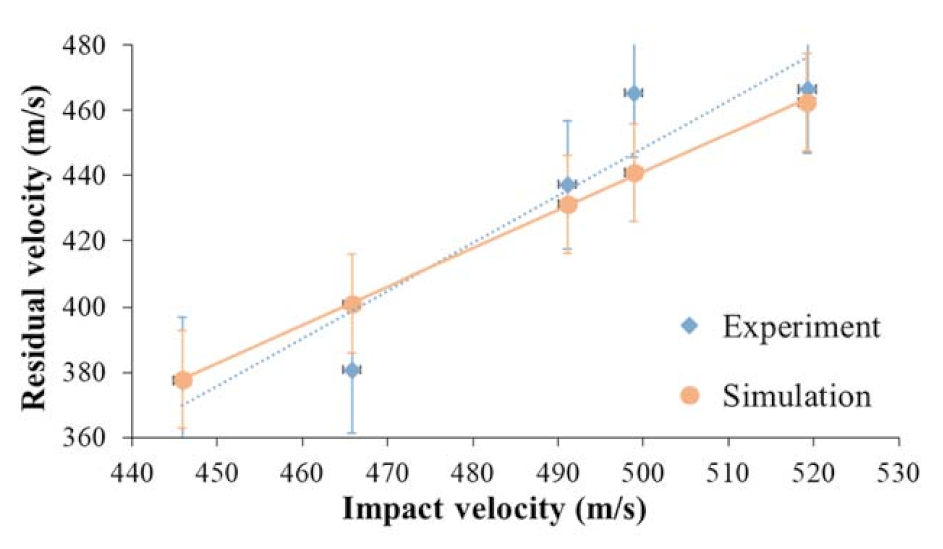



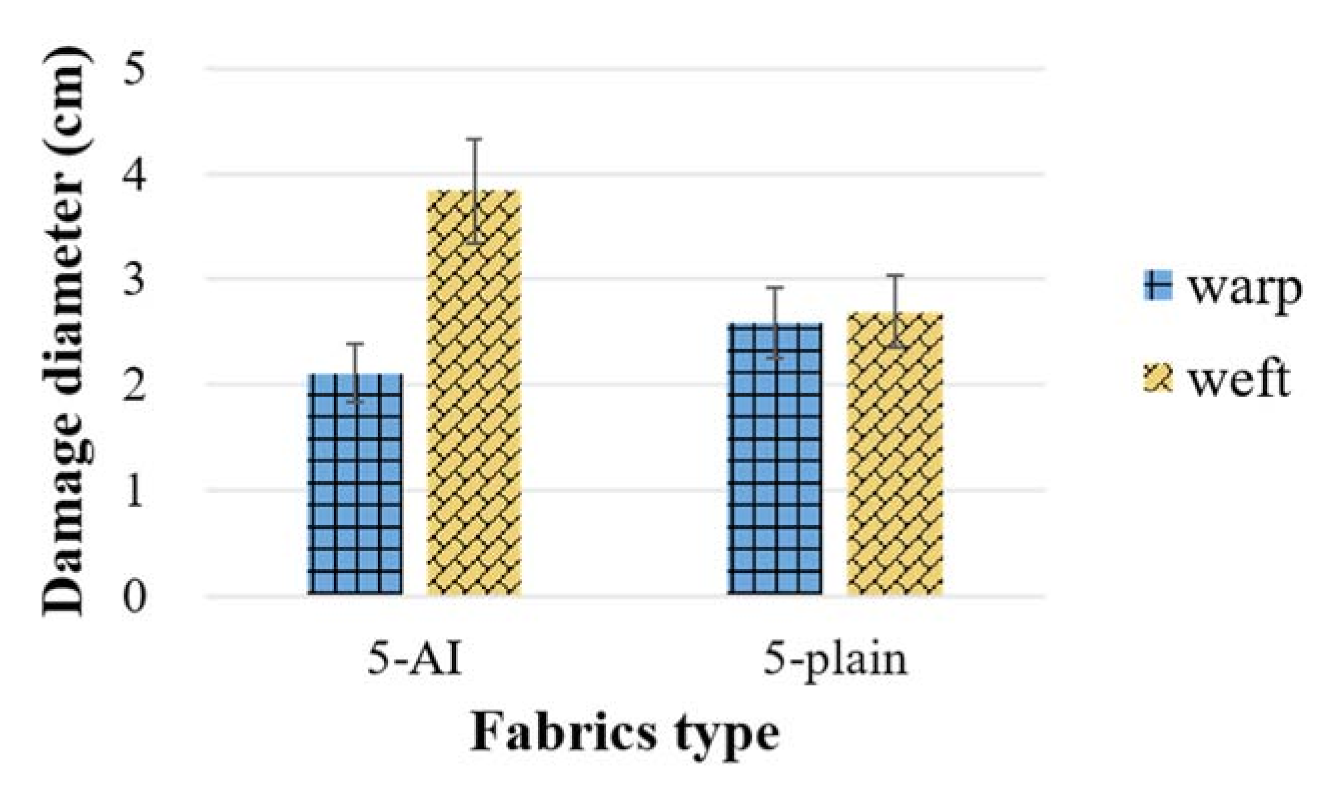

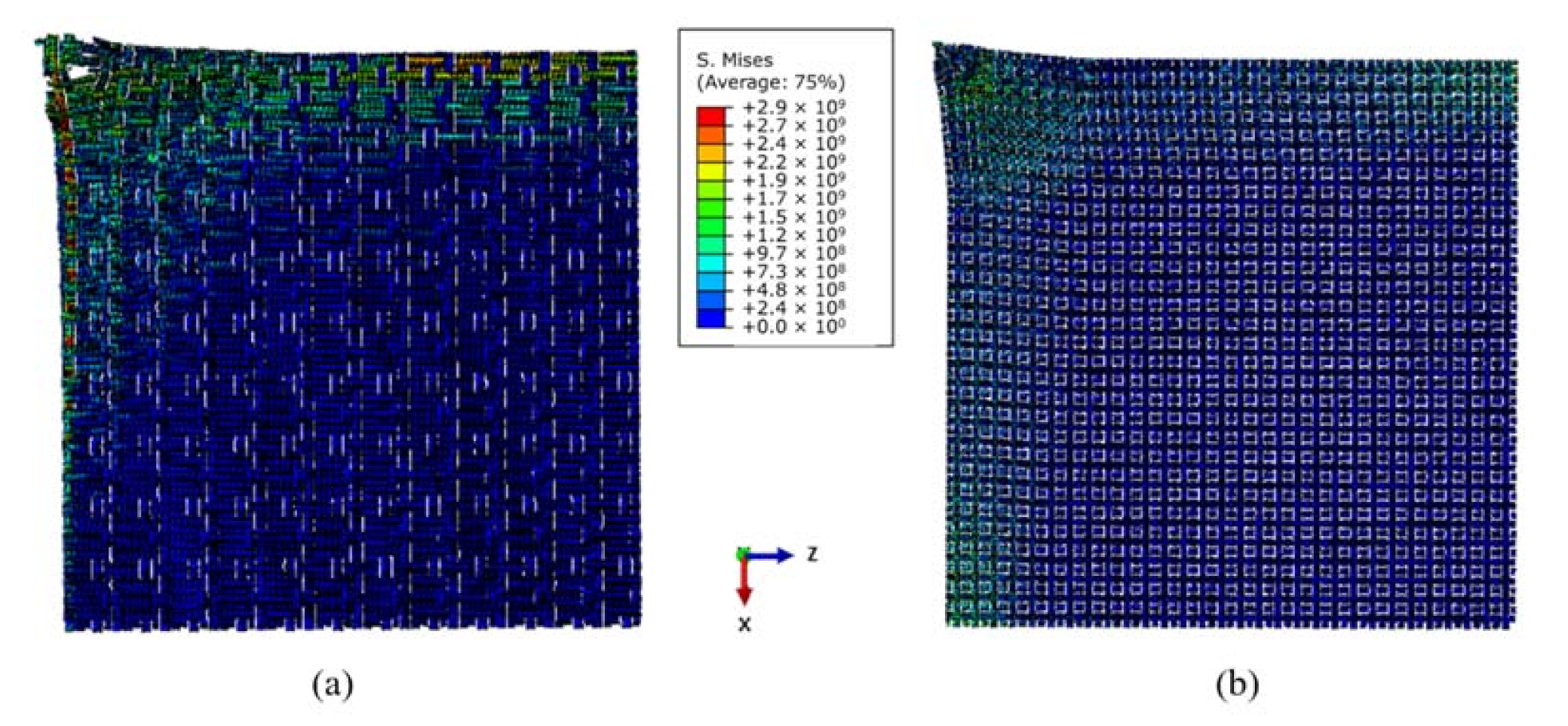
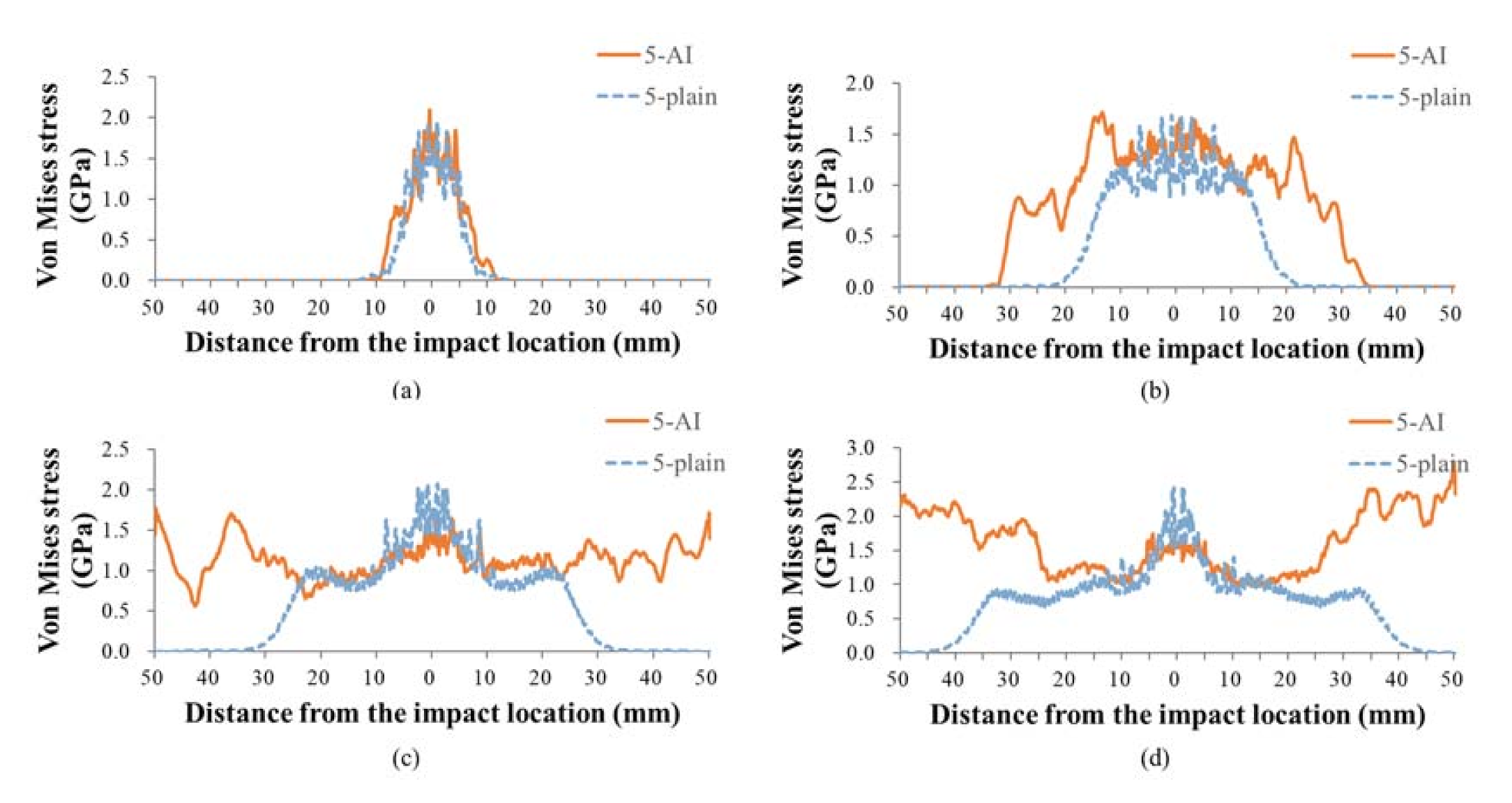
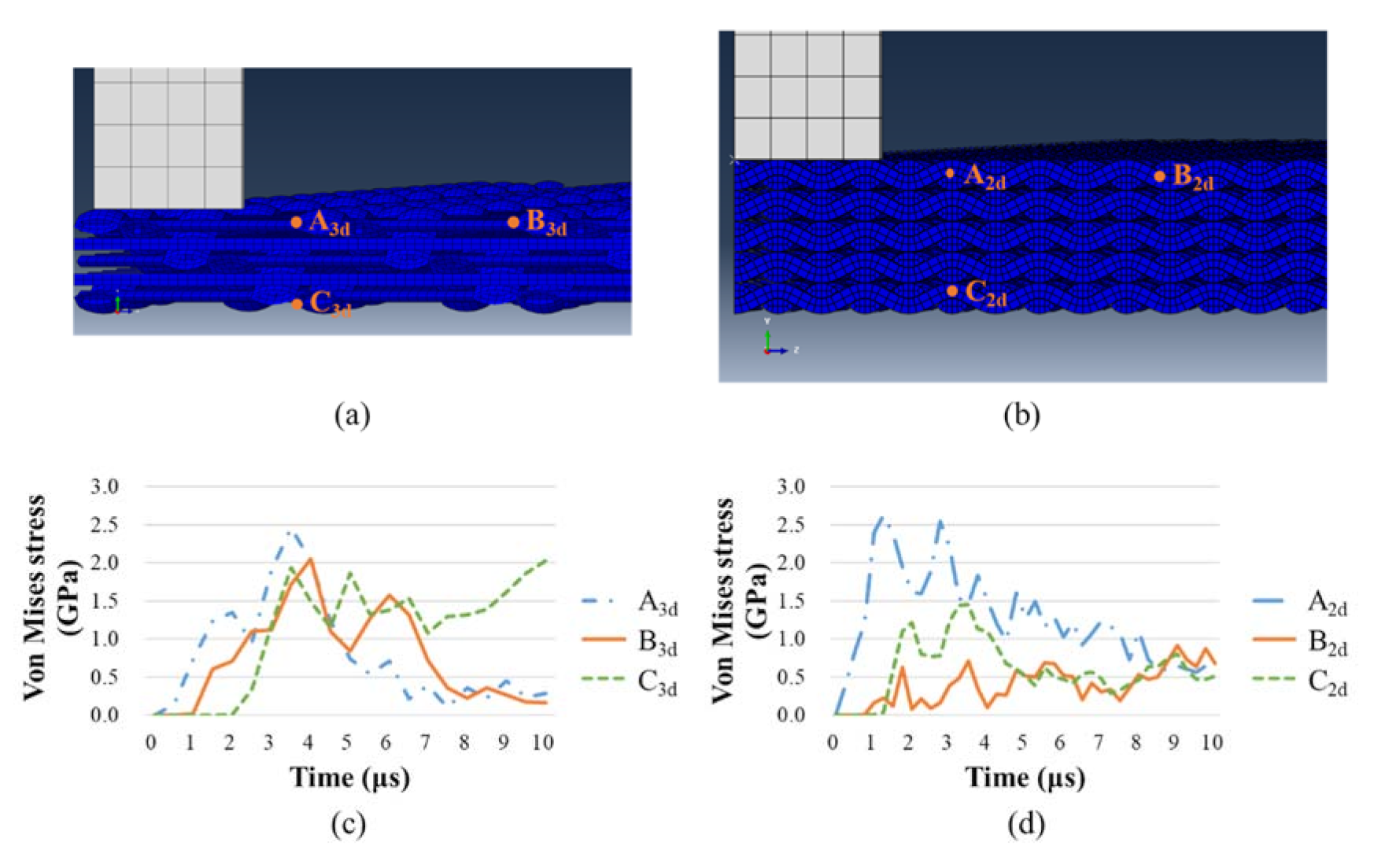
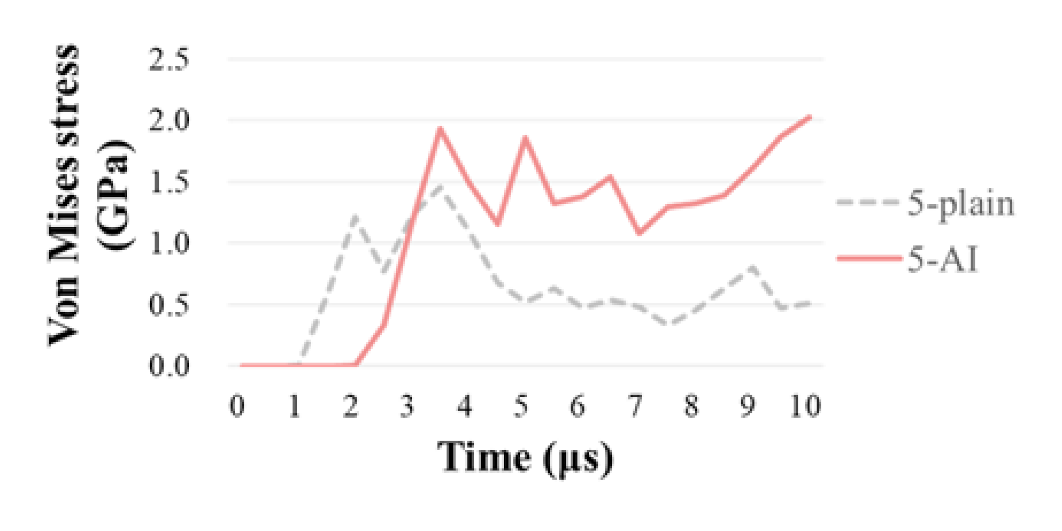
| Fabrics Type | Yarn Density (tex) | Spacing of Warp Yarns (mm) | Weft Density (picks/cm) | Thickness (mm) | Size (cm × cm) | Areal Density (g/m2) |
|---|---|---|---|---|---|---|
| 5-AI | 158 | 0.83 | 37 | 1.98 | 10 × 10 | 814 |
| 3-plain | 0.83 | 12 | 1.77 | 5 × 5 | 1162 | |
| 5-plain | 0.83 | 12 | 2.95 | 5 × 5 | 1937 | |
| 4-TTAI | 0.83 | 30 | 1.67 | 15 × 15 | 684 |
| Materials | Mass Density (kg/m3) | Young’s Modulus (GPa) | Poisson’s Ratio | Yield Stress (GPa) | Fracture Strain (%) |
|---|---|---|---|---|---|
| Para-aramid yarn | 1440 | 72 | 0.35 | 2.9 | 4.28 |
| steel | 7800 | 209 | 0.35 | - | - |
| Fabric Type | Residual Velocity (m/s) | SEA (J·cm2/g) | Peak Accelaration (×106 m/s2) |
|---|---|---|---|
| 5-AI | 410.75 | 392.97 | −4.63 |
| 3-plain | 428.50 | 208.91 | −4.33 |
| 5-plain | 383.15 | 223.97 | −8.97 |
Publisher’s Note: MDPI stays neutral with regard to jurisdictional claims in published maps and institutional affiliations. |
© 2021 by the authors. Licensee MDPI, Basel, Switzerland. This article is an open access article distributed under the terms and conditions of the Creative Commons Attribution (CC BY) license (http://creativecommons.org/licenses/by/4.0/).
Share and Cite
Yang, Y.; Zhang, X.; Chen, X.; Min, S. Numerical Study on the Effect of Z-Warps on the Ballistic Responses of Para-Aramid 3D Angle-Interlock Fabrics. Materials 2021, 14, 479. https://doi.org/10.3390/ma14030479
Yang Y, Zhang X, Chen X, Min S. Numerical Study on the Effect of Z-Warps on the Ballistic Responses of Para-Aramid 3D Angle-Interlock Fabrics. Materials. 2021; 14(3):479. https://doi.org/10.3390/ma14030479
Chicago/Turabian StyleYang, Yingxue, Xiuqin Zhang, Xiaogang Chen, and Shengnan Min. 2021. "Numerical Study on the Effect of Z-Warps on the Ballistic Responses of Para-Aramid 3D Angle-Interlock Fabrics" Materials 14, no. 3: 479. https://doi.org/10.3390/ma14030479





